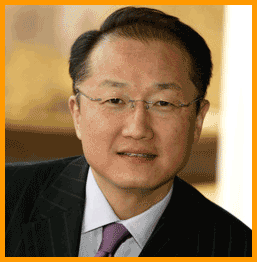In 2006, Jim Yong Kim was named one of Time Magazine’s top 100 most influential people. In 2003, he received the MacArthur “Genius grant”. He is the chief of both the Department of Social Medicine at Harvard Medical School and the Division of Social Medicine at Boston's Brigham and Women's Hospital, and he was the director of the HIV/AIDS division of the World Health Organization(WHO). On top of all that, he is married with an eight-year old son.

Jim Yong Kim |
Dr. Kim earned his undergraduate degree from Brown University, and received his MD in 1991 from Harvard Medical School. Two years later, in 1993, Kim completed his medical training with a PhD from Harvard University.
Jim Yong Kim has been a member of Partner’s In Health since it’s founding in 1987. In 1996, Kim formed a division of PIH called Socios en Salud, based in Peru. The structure of Dr. Kim's work to imitated Dr. Farmer’s achievements in Cange, except that in Peru, AIDS was replaced by a drug resistant strain of TB, which is much harder to treat than regular TB. This particular strain is five-drug-resistant, and is today known as MDR-TB or XDR-TB, depending on its severity of resistance. The strain had developed from following the orders of the WHO’s DOTS program (directly observed treatment short-course therapy). The patients had started out with one or two-drug-resistant TB, and because the DOTS program did not treat their strain of TB, it had developed into five-drug-resistant TB. After the cases became too complicated, the national program abandoned those patients with five-drug-resistant TB and the patients were left hopeless, without the money needed to afford a pulmonologist or a cure. Some families sold most of their possessions to buy the expensive second line drugs prescribed by the pulmonologists. However, they were not able to afford enough of the drugs to achieve affective treatment, and the TB just developed more resistance.
Dr. Kim called on Paul Farmer’s assistance and advice almost daily. They were able to force down the price of the necessary drugs by about 90%, and in August of 1996 they started treating patients. According to the PIH 2006 Annual Report, 500 patients in Peru were declared “completely cured” and another 500 were continuing to receive the “medical treatment, nutritional, social, and economic support” that they needed to defeat the TB. The program was successful and is now used in 36 countries around the world.
His success against Drug Resistant TB gave Dr. Kim confidence when he became director of the HIV/AIDS division of the WHO. As of 2003, only 300,000 people in the developing world were getting treatment for HIV/AIDS. Kim, inspired by his success against the Drug Resistant TB epidemic he fought in Peru created the "3 By 5 Campaign" in 2003. The aim of the 3 by 5 was to increase the number of patients getting treatment for HIV/AIDS to 3 million by the year 2005. Many experts claimed it was an impossible goal to reach in only 2 years, and they were right. However, by 2005 the number of patients getting treatment for HIV/AIDS increased by over 1 million. There were 8 times as many HIV/AIDS patients getting treated in Africa than there had been in 2003. Kim described the 3 by 5 as a "bowling ball thrown into a chess match.” In just 2 years, he had accomplished enough to convince many public officials previously skeptical of the feasability of his plan that backing the program was not only a wise move, it was a humanitarian obligation.
Although he had worked his way up to the number two position in the World Health Organization, Dr. Kim eventually left when he became frustrated by the red tape culture- he found himself unable to get anything done. At PIH it was the opposite case; according to Tom White, “That's one of the things that made PIH able to work, because most organizations say ‘well, we'll consider it, or we'll take it under advisement, we need more information, etc, etc.’ It goes on, it seems like forever.” PIH doesn’t ever say no to a project; if it’s about saving lives, the Partners can’t refuse.
Jim Yong Kim wears three hats now, as the chief of the division of Social Medicine Health and Equality at the Brigham and Women’s Hospital, the chair of the division of social medicine at Harvard Medical School, and the director of the François-Xavier Bagnoud Center for Health and Human Rights at the Harvard School of Public Health. Dr. Kim is still involved in PIH, but more in the academic areas than in the clinical day to day work . He is also working on finding a way to create what he is calling “Global Health Delivery”, in other words, scaling up PIH’s model for global implementation. Kim also devotes significant time to illiciting the aid of other other organizations, because PIH cannot save the entire wold on its own.

